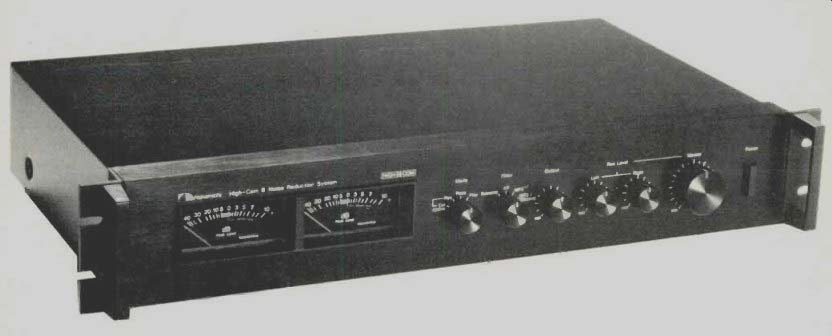
Manufacturer's Specifications
Compression Ratio: Encoding, 2:1; de coding, 1:2.
Noise Reduction: 20 to 25 dB.
Distortion: 0.1 percent at reference level.
Frequency Response: 20 Hz to 20 kHz, ±1 dB.
Input Sensitivity: Line, 60 mV; tape playback, 200 mV.
Output Level: To recorder, 300 mV; line, 600 mV.
Dimensions: 19 in. (482 mm) W x 3-7/32 in. (82 mm) H x 10 3/8 in. (270 mm) D.
Weight: 11 lbs. (5 kg).
Price: $480.00.

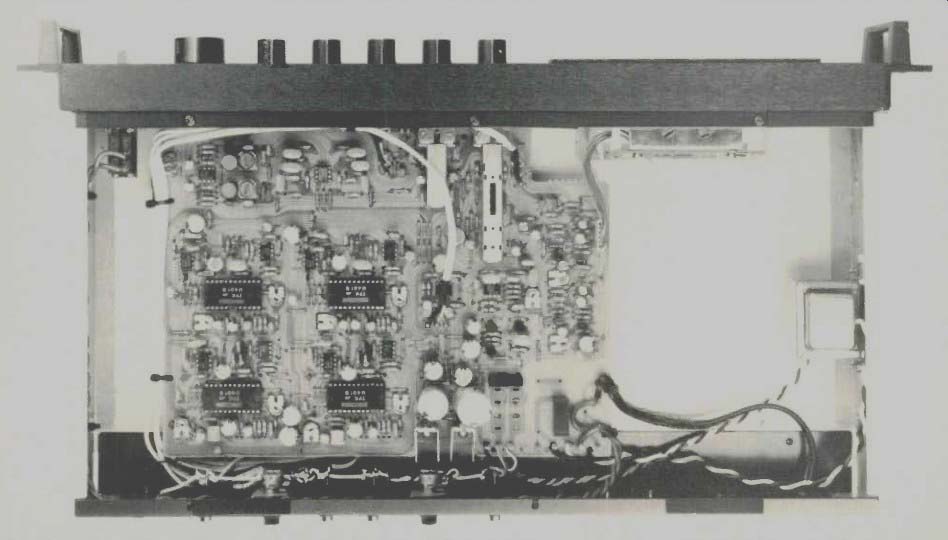
The Nakamichi High-Com II noise-reduction system, developed in cooperation with Telefunken, should be of immediate interest to many because of its claims for improved performance over both Dolby and dbx II NR systems. The basis for these claims and the results of the performance and listening tests appear later in this article. First, let's take a look at the front panel of the unit. The channel level meters cover a range from-40 to +10 dB. The white scales are well illuminated against a black background, and are very legible over a wide range of ambient lighting. There is a short red index lined up to meter zero and labeled in red, "20 mM/mm," and that is hard to read. (Note: 20 mM/mm is 20 milli-Maxwells/ mm, the same as the more common form for Dolby flux level: 200 nWb/m, or nano-Webers/m.) Two four-position rotary switches control Mode and Filter selection: Cal 400 Hz, Rec, Pass and Play for modes, and Subsonic, Off, MPX and MPX/Subsonic for filter settings. The High-Com II unit re viewed here has one set of stereo processors and must be switched to encode (recording) or to decode (playback). It cannot do both at the same time-a second unit is required if simultaneous record/encode-playback/decode is desired.
In Cal, a 400-Hz tone is shown at 0-dB reference level on both meters and fed to the line inputs of the associated tape recorder. With its level controls at maximum, set pots on the back of High-Corn II are used to set indication on the recorder's meters for a recorded level of 200 nWb/m, or Dolby level. The recorder, of course, should not be in Dolby mode. The recorded test tone is played back, and other set pots on the back are used to get the reference-level indications in Play mode. Once calibrated, the recorder controls and the set pots are not used. Setting of input levels is done with the High-Com II's separate channel-level controls and the master pot. There is an output pot which controls the level to the outside world--the preamp tape monitor input, for example. The subsonic filter is designed to cut out below-band signals, such as might be generated by record warps. The multiplex filter should be used to remove any 19-kHz pilot tone in the output from an FM tuner or receiver. The filters remain in the Rec signal path in Pass, so it's possible to use them without the noise reduction-a nice design touch.
The black-anodized front panel with white lettering matches other current Nakamichi products, and all the labels are quite legible even with medium-dim illumination. The top and side cover is steel, adding to the rugged construction which includes accessory rack-mounting brackets. The unit will fit in a 31-inch high rack space with the feet removed, but the mounting slots will not match some racks unless the chassis is slid up or down from a normal position.
Inside the unit was one large p.c.b. which had excellent soldering with substantially no flux residue. Off-card connections were with wirewrap, in general, with one multi-pin cable used. Parts were identified on both sides of the p.c.b. The Telefunken processor chips were easy to locate: Four large, 24-pin ICs in sockets, labeled "TFK U401B." There were also many discrete components, as well as a dozen 4558 dual-amp mini-dip ICs. There certainly was a lot more circuitry in evidence than might be expected from comments to the effect that High-Com II utilized a new Telefunken chip based upon their professional noise-reduction system, Telcom C4D.
Circuit Highlights
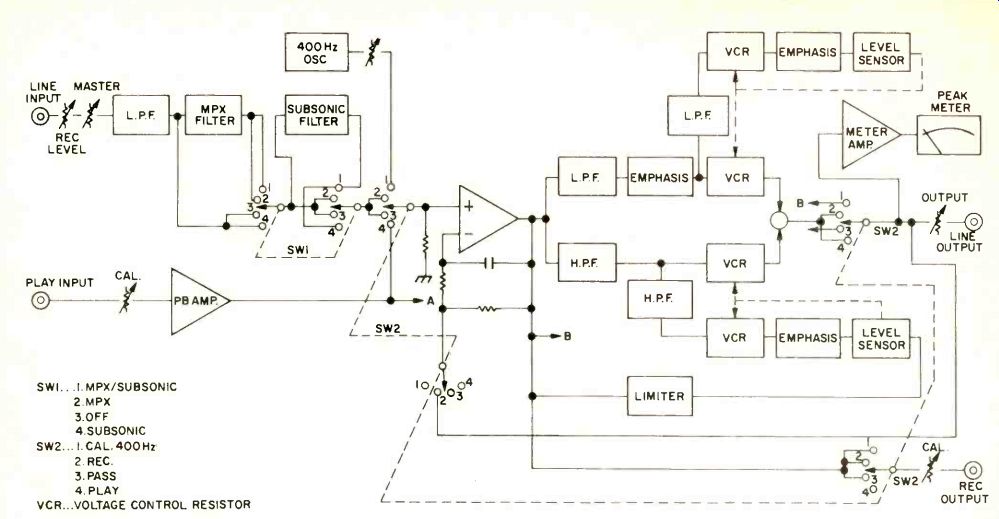
Fig. 1-Circuit diagram of one channel of Nakamichi High-Com II noise-reduction
system.
One channel of the High-Com II noise-reduction system is shown in simplified block form in Fig. 1. Most readers will probably be able to follow the various signal paths, but a few comments are in order. Note that there is a low-pass filter on the line input at all times; this keeps out above-band garbage that could affect the processing. SW1 makes the filter selections in the record-signal path, and SW2 selects the operating mode, including Cal and Pass. In record, the output of the two-band processor is fed back to be subtracted at the input, which obtains the desired encoding compression. In play, the PB Amp feeds the processor, and the expansion of the decoding removes the previous compression.
The processing involved and the rationale for the Highcom II's design can be understood more easily with close examination of Fig. 2. The reference point for the system, and the following discussion, is where the input and output levels are both at 0 dB--which is the calibration reference level discussed previously. Let's take a look at what happens first:
Recording with encoding. The incoming signal is compressed 2:1 on a dB basis with the result that a range of signals from +20 to-20 dB at the input are fed to the recorder with a range from +10 to-10 dB. Below an input level of about-23 dB, the compression at 50 Hz ceases--evidenced by the change to the 45-degree slope. Because of the earlier compression, however, an input level of-50 dB is fed to the recorder at about-40 dB, or 10 dB higher, relatively. We can see that there are similar break points for 400 Hz at an input level of about-33 dB and for 3 kHz at about-37 dB. A-50 dB input at 400 Hz is fed at-34 dB to the recorder; the same level at 3 kHz is fed at-31 dB. The separate line for 10 kHz shows that there is a roll-off at 10 kHz in addition to the compression; this will be clearer in looking at the later response plots. The 2:1 compression continues at 10 kHz to about-47 dB, when the feed to the recorder is about 25 dB down.
The audio signal, of course, does not consist of just four discrete frequencies, but the curves do show how the processing varies with frequency. We can see that the lowest frequencies have the least compression, and the highest frequencies have the most. Similarly, the decoding applied during playback is the complementary function which expands those levels that have been compressed in accordance with the basic 1:2 relationship, modified by the frequency content We might note at this point that this High-Com II system has some similarities to both dbx II and Dolby NR systems and, of course, some differences. Right off the bat, there is a 400-Hz reference tone, and the associated flux level is exactly the same as with Dolby Type B (nonprofessional) systems.
The 2:1 compression in encoding and the 1:2 expansion in decoding are the same as in dbx II. There are important differences, however, and they are the basis for some of the manufacturer's claims.
First of all, we would note that the compression in encoding stops at a certain point as the level is being reduced, returning to a dB-in/dB-out relationship, while dbx II's slope is constant. Nakamichi claims this reduces negative effects that occur with compression/expansion in the noise-limited region. The Nakamichi High-Com II scheme uses two frequency bands of processing to further reduce noise pumping and other spectrum interactions, while single-band operation is used in Dolby B and dbx II. Because of the greater compression all the way across the band compared to Dolby, High-Com II can offer 10-dB greater noise reduction across the entire audio band. A rough summary of the claimed ad vantages would be this: High noise reductions as with dbx II without noise pumping, and much higher noise reduction than Dolby all across the band. To gain better judgment on these claims, the test program included comparisons among High-Com II, dbx II and Dolby B.
Performance
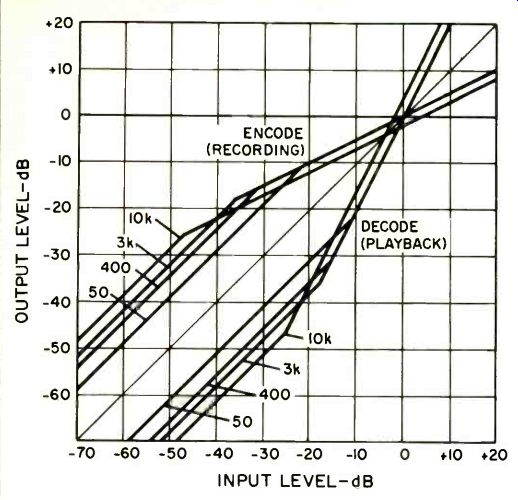
Fig. 2--Encoding and decoding characteristics.
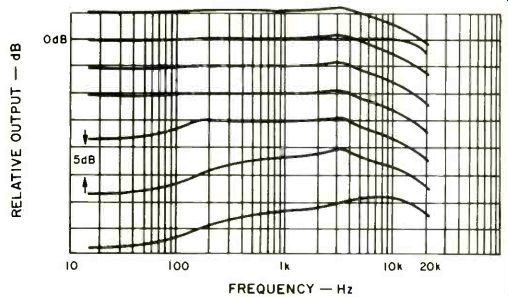
Fig. 3--Frequency response of record processor with 10-dB steps from +10 to
-50 dB, re reference level.
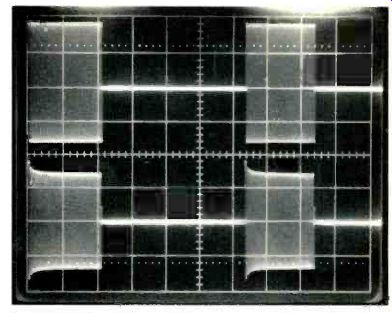
Fig. 4--Record processor response to 10-mS 2-kHz tone burst.
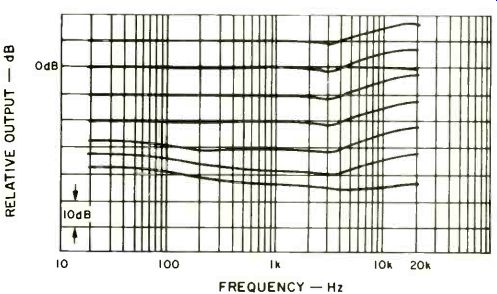
Fig. 5--Frequency response of play processor with 5-dB steps from +5 to -25
dB, re reference level.
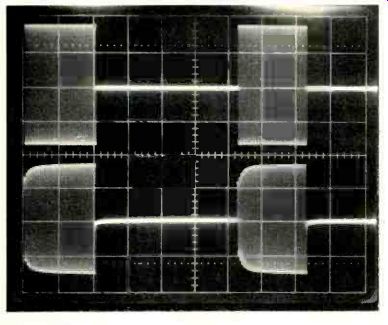
Fig 6--Play processor response to 10-mS 2-kHz tone burst.
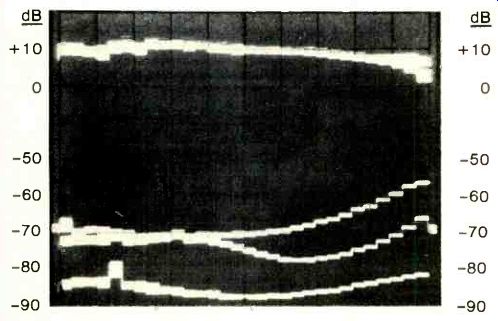
Fig. 7--Responses with High-Com II and Dolby NR; see text.
To check the action of the encoder at various levels across the band, swept responses were made with inputs from +10 to-50 dB. As Fig. 3 shows, the first steps were 5-dB ones on the output. Then, with the input at-30 dB, the lowest frequencies are moving out of the compression portion of their curves (Fig. 2.). In the next two steps of 10 dB each, most of the audio band moves down into the linear section. Also note that the high end rolls off above 4 kHz, being down about 7 dB at 20 kHz at the output of the processor. This is a desirable characteristic to minimize high-frequency overload in recording, particularly below 0 dB where the compression raises levels that would normally be lower. The 50-dB spread in input levels from 0 dB down has been reduced to 29 to 38 dB, depending upon frequency. Figure 4 shows the encoder response to a 10-mS 2-kHz tone burst; it will be compared with the decoder response later.
The frequency/level response of the decoder was checked in similar fashion with 5-dB level steps at its input. It is not possible to find matching curves, because a flat output from Play would require an input sweep such as shown in the encoder plots. Without two units to do simultaneous encoding/decoding, it was necessary to do a little calculation of specific points, which showed the net response to be quite flat. Figure 6 shows the decoder response to the 10-mS 2-kHz tone burst, and it appears that the total effect of the two functions should make a very good waveform.
The next step was to measure High-Com II's noise-reduction capability compared to Dolby NR and to no noise reduction. A comparison in responses at +10 dB was also made. A Nakamichi 680ZX cassette deck was used for the tests with its output fed to an Ivie IE-30A spectrum analyzer. The Ivie 1/3-octave spectrum output was stored on a Tektronix 5111 'scope to allow showing all curves at the same time (Fig. 7.).
Immediately take note of the fact that the vertical scale is broken between the zero reference and "-50 dB." With metal tape and the pink-noise source and the ex tended response of the 680ZX, there wasn't a great deal of roll-off with a +10 dB level on the meters. It is possible to see, however, that there is more roll-off with Dolby NR than with High-Com II. (The new Dolby HX scheme should not show this limitation.) The topmost curve in the lower set of three is the noise output from the recorder with Nakamichi ZX tape without any sort of NR. The middle curve is the noise output with Dolby processing and shows a fairly constant 10-dB improvement above 3 kHz. With High-Com II (bottom spectrum), the reduction is 20 dB or more over a good part of the spectrum, with reductions of 10 dB or more compared to Dolby NR. Especially noteworthy is the sizable reduction at the lower frequencies, where Dolby NR was actually slightly higher in noise than without NR, and at the highest frequencies where the noise with Dolby NR curves up more sharply. Relative to the reference level, the signal/noise ratios were 61.6 dBA with Dolby NR and 71.5 dBA with High-Com II. Relative to the level for HDL3 = 3%, the ratios were 67.1 dBA with Dolby NR and 82.0 dBA with High-Com II, certainly a most impressive number. Obviously, the compression above zero level effectively shifts the distortion limit to a much higher input level, although it's the same actual level on the tape.
Distortion tests were attempted on the unit, but only general conclusions could be drawn. With a compressor, for ex ample, what's the significance of a harmonic so many dB down? Will it be expanded back down into noise? Two units are really needed to prove that the two functions complement each other for minimum distortion. Most distortion components appeared as though they would be at least 57 dB down, or about 0.14 percent--only two-unit tests would tell positively. In record/playback tests, HDL3 at 1 kHz was higher at some levels with NR than without--always less than 0.2 percent, but there was a shift.
The subsonic filter was 3 dB down at 26 Hz, 13 dB down at 20 Hz, and 38 dB down at 10 Hz. The multiplex filter was-3 dB at 16.8 kHz and 30 dB down at 19 kHz. The input low-pass filter was-3 dB at 25.9 kHz and 10 dB down at 38.7 kHz. The meters were 3 dB down at 10 Hz and 24.4 kHz. The response time was about 140 mS, fairly fast compared to a standard VU meter, but isn't a true peak level type. Line input sensitivity was 52 mV; record out level was 290 mV. Play input sensitivity was 182 mV; line out level was 540 mV. All of these figures are substantially to spec, but the source impedance of record out (5 kilohms) is on the high side for general use, and the IHF load caused the level to drop to about 200 mV.
Use and listening Tests
Because Dolby B and dbx II had been used successfully in many cases, I conducted a few tests for direct comparison. Records were used, as it was desirable to be able to switch among the three systems and the original at any point. In general, there was a lot of good reproduction from all of the systems. With The Great Organ record, with Michael Murray, High-Com II had a slightly better articulation, a cleaner sepa ration between bass and treble than the other two schemes--particularly when there were low pedal notes. In the quiet portions, it was possible to hear the reduction in noise with High-Com II compared to Dolby B. The Fiedler/Boston Pops direct disc of Tchaikovsky's Capriccio Italien gave similar evidence, and there were also a few low-level passages where there was some breathing noted with dbx II. Another test used a mike pickup of speech with music playing in the background and a heater blower running off and on. For those who haven't had the experience, this odd combination is not so far from some of the conditions you might find in remote recording. In this case, Dolby B performance appeared to be just as good as High-Com II, and the play back sounded natural. The dbx II system, however, generated a number of odd gain changes from some sort of interaction between the processing, the low-level music, and the whir ring of the heater blower.
The actual test time was short, particularly in comparison with the number of hours spent with other NR systems. High-Com II did perform well in the tests, and the listening experience was quite impressive. The noise reduction was definitely greater than with Dolby B, the high-level high-frequency headroom was greater, and the low-level breathing/pumping was less than with dbx II. The dollars for High-Com II are not low, but the performance warrants a good look.
-Howard A. Roberson
(Adapted from: Audio magazine, Sept. 1980 )
Also see:
Nakamichi 1000ZXL Limited Cassette Deck (Sept. 1982)
Nakamichi 1000 ZXL Cassette Deck (Equip. Profile, June 1981)
Nakamichi cassette decks (Dec. 1982)
Nakamichi Model 600 Stereo Cassette Console (Sept. 1976)
Nakamichi CR-4A Cassette Deck (Aug. 1988)
Nakamichi 680ZX Stereo Cassette Deck (Equip. Profile, Sept. 1980)
Nakamichi 1000 DAT Recording System (Nov. 1989)
= = = =